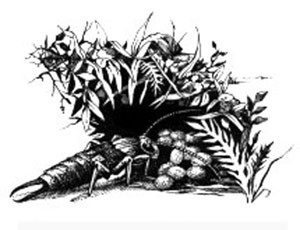
An earwig still evokes a shudder after many centuries, for the insect’s Old English name, earwicga (”ear” and “worm”), suggests it might crawl into your ear when you are asleep and do terrible things to your brain with its rear-facing pincers. The meaning of the word earwig somehow later evolved to also mean “whisperer” (more appropriate for a harmless little insect), which, if it has anything to whisper to us, would tell about motherhood.
Of about 18 kinds of earwig in North America, the alien European species is the most common in Vermont and New Hampshire. One justified complaint against these particular earwigs: They feed enthusiastically upon flowers, fruits and other delicate vegetation, but you seldom find them doing so, for they are nocturnal and seek cover by day. Discernible damage does occur in gardens when a large, concentrated population of earwigs is present, so trying to eradicate them is understandable.
It is their habit of hiding indoors under objects and damp places that makes their discovery disconcerting, for they may be mistakenly equated with unsanitary conditions. Not so, although if vegetable debris is forgotten and left uncovered, earwigs are likely to find it. A flattened body allows them to enter through the smallest cracks and eagerly explore the cleanest house.
Prominent pincers at the end of an earwig’s abdomen are sometimes used for defense against other insects and appear scary enough for the insect to be summarily squashed by humans. If you pick up one, it bends its supple abdomen around and nips you firmly, but the pinch doesn’t hurt. The pincers’ primary function is as a tool.
An earwig appears to be flightless, as in fact some species are, but not our common variety here in the north. Despite a pair of short wing cases over the mid-portion of its body, no wings cover the segmented abdomen. Nevertheless, an earwig can fly. To understand how, you must be patient and watch carefully, because translation of a former scientific name, Euplexoptera, taken from Greek, described the insect as having “well-folded wings.”
When preparing to take to the air, an earwig raises its wing covers, bends its abdomen into a U-shape until the pincers face forward, then uses them as delicate forceps to pull out and unfold the wings. Unlike other insect wings, those of an earwig have radiating veins resembling an oriental fan. After the wings are fully extended, the earwig flies away. When it lands, the wings first fold by themselves lengthwise in plaits like the fan they resemble, after which the tips fold crosswise, then crosswise again, until finally the pincers tuck the neat package of compacted wings back under their two small protective covers. For efficiency and economy of space, it is biological engineering at its best, and there is little in the animal world to match it. When I watch the space shuttle tuck its mechanical arms and equipment back into the cargo bay, then close the pair of curved doors, I think of our earwig neighbors doing the same thing, but with far greater precision.
What about motherhood? A female earwig displays true maternal care, unusual among insects. She lays 12 to 15 smooth, white eggs in a secluded nest, hidden from the outside world. She then sits on the nest, curling her body about the eggs, brooding (but not incubating) them like a hen. If the nest is disturbed, or begins to dry out, she carries the eggs to a more favorable spot.
After four weeks, whitish juvenile earwigs hatch, but don’t travel far from the nest. They resemble their mother but are lighter in color and lack wings. The female remains with her young, continuing to brood and feed them with a nutritious regurgitated substance. If danger threatens, or the nest is uncovered, she gathers the active youngsters around her and, in a threatening display, elevates her pincers in the direction of the intruder. Eventually the young leave the nest, but only after molting several times, growing larger and darker with each molt, and finally being equipped with wings. Now they seek their traditional succulent plant food, nearby, if possible. Thus a local population increases.
Parental care as a guardian of unhatched eggs, as well as of developing young, places an earwig apart from all other insects, except a few kinds of beetles. The earwig therefore qualifies as a social insect. I’ve found dozens of adults nestling peacefully together in a daytime retreat of furled milkweed leaves. Better-known social insects such as bees, wasps, ants and termites, are more concerned with their particular roles in a nest’s hierarchical community than they are with the thousands of their expendable eggs.
Earwigs are not popular, so swat if you must. Remember, though, the earwig whispers her message of age-long survival through the eyes of admiring naturalists. And to her dozen eggs and hatchlings, she is a very good mother.


Discussion *